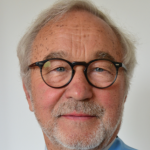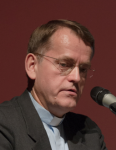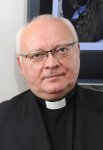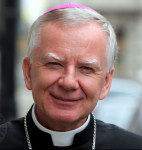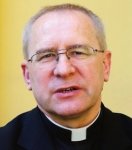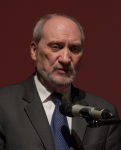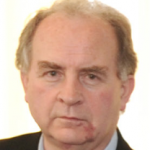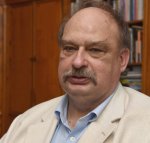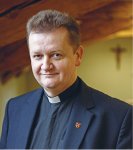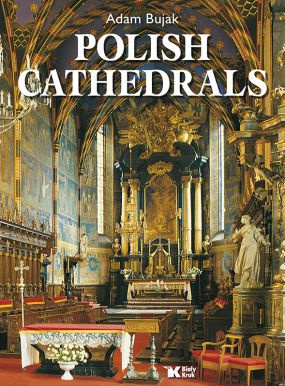Katedry Polski (ang) // Polish Cathedrals
| liczba stron: | 312 |
| obwoluta: | nie |
| format: | 235x300 mm |
| papier: | 170 g kreda błysk |
| oprawa: | twarda lakierowana |
| data wydania: | 17-03-2007 |
| ISBN: | 978-83-60292-37-2 |
 dodaj do przechowalni
dodaj do przechowalni
Wyrazem kultury duchowej i materialnej wiernych są świątynie, wśród których szczególne miejsce zajmuje katedra – matka i głowa wszystkich kościołów. Miejsce, które w szczególny sposób jednoczy wiernych każdej diecezji.
Adam Bujak sfotografował polskie katedry i konkatedry, tworząc monumentalne dzieło. W albumie zamieszczono niezwykłe zdjęcia – będące nie tylko dokumentem, ale także przepełnione szczególną atmosferą tych niezwykłych świątyń. Podstawowym środkiem artystycznym, podobnie jak dla budowniczych gotyckich katedr, było dla artysty fotografika światło. „Na ten jedyny właściwy promień czekałem nieraz godzinami” – mówi Adam Bujak. W cudowny i tajemniczy świat katedr wprowadza znakomicie tekst ks. inf. Stanisława Bogdanowicza, kustosza Bazyliki Mariackiej w Gdańsku. W publikacji uwzględniono najnowszy podział administracyjny Kościoła polskiego (nowe katedry w Bydgoszczy i Świdnicy).
The history of faith embodied in stone 5
Cathedral locations in alphabotic order 12
List of use ful terms 13
Gniezno 14
Włocławek 26
Bydgoszcz 30
Kraków 36
Kielce 50
Tarnów 56
Bielsko-Biała 60
Żywiec 64
Poznań 68
Kalisz 78
Ostrów Wielkopolski 84
Warszawa 86
Warszawa-Praga 92
Płock 98
Wrocław 108
Legnica 114
Świdnica 120
Przemyśl 126
Zamość 132
Lubaczów 140
Rzeszów 142
Szczecin 146
Kamień Pomorski 150
Gorzów Wielkopolski 158
Zielona Góra 164
Koszalin 166
Kołobrzeg 170
Gdańsk-Oliwa 176
Gdańsk 184
Peplin 192
Toruń 200
Chełmża 210
Frombork 218
Olsztyn 224
Elbląg 228
Kwidzyn 232
Prabuty 234
Ełk 236
Gołdap 238
Suwałki 240
Białystok 242
Łomża 246
Drohiczyn 250
Częstochowa 252
Sosnowiec 256
Radom 260
Katowice 264
Opole 268
Gliwice 272
Lublin 274
Sandomierz 280
Stalowa Wola 286
Siedlce 288
Łódź 292
Łowicz 298
Warszawa 308
The history of the Cathedrals is thehistory of faith embodied in stone,enclosed in sculpture, expressed inpainting, re-echoed in the soundof the organ. The origins of theirstory go back to the very beginningsof Christianity. The Cathedralsare Houses of God and Houses ofMan, in which our ordinary everydayhumanity encounters the Divine. Butthe origins of the Cathedrals also goback to the ordinary home.The Acts of the Apostles tell us howall the followers of Christ would worshipin the Temple together, alreadyasa distinct group within the congregationof Israel. The Acts use theword ecclesia, εκκλησια, to describethem,a word which means „officialassembly” or „congregation”,„Church”.
While participating in the life of theirnation, the Christians were alreadyleadinga life of their own. On leavingthe Temple of Jerusalem they wouldgather in their private homes, as theyhad done in the Upper Room, wherethe entire early community used toassemble. Later on there were moreand more such places. The Acts ofthe Apostles tell us that „day by day,attending the Temple together andbreaking bread in their homes, theypartook of food with glad and generoushearts” (2.46.).We know of one of these houses,„the house of Mary, the mother ofJohn whose other name was Mark,where many were gathered togetherand were praying” during Peter’simprisonment (12.12.). Some ofthese meetings took place at night,especially the night of Saturday andSunday. During one of these prayermeetings held by night Peter, whohad been freed from prison, appearedand „knocked at the door ofthe gateway”. The Christians wouldcollectively attend prayers on theSabbath, after which they wouldmeet in their own company.We can imagine these meetings.There would bea teaching, followedby „the breaking of bread”. Nextprayers would be said. There wouldalso bea meal in which all wouldparticipate. Originally these meetingswould be held ina room givenby the master of the house for use tothe Christian community. With timesucha room might have come tobe permanently reserved for Divineservice.
One of the Christians might occasionallyhave made his houseavailable for the more importantgatherings. Ina passage of thePseudo-Clementine „Recognitiones”we read, thata certain Maro hadoffered St. Peter his house (aedes)and inner garden, which couldaccommodatea total of five hundredpeople.
The essential developments in thisrespect came in the early 3rd century.For that period we already comeacross mentions of special buildingsfor the worship of God. Theycoincide with the relatively peacefulpontificates of Popes Zefirinus andCallixtus. At this time the Churchcould have already had her ownburial grounds.We have managed to discover theremains of these first „churches”.One of them, the date of which canbe established the most reliably, isthe church in the frontier fortressof Dura Europos.a Christian housedated around 232 has been discoveredin this ancient town (Arabicname Kalat as-Salihijja) on the middlestretch of the Euphrates, whichwasa centre of the Hellenist cultureinhabited chiefly by the aristocracyand administrative classes.In terms of construction this housewas no different from other residentialbuildings. It enclosesa squarecourtyard. The large rectangularhall on the ground floor of its southwing served asa place of worship.a small room on the northern sidewas converted intoa baptistry,witha basin built into the floorundera canopy supported on twopillars. Some frescoes depicting theGood Shepherd and scenes fromthe Bible have been discoveredthere. The rest of the house musthave served as the bishop’s residentialquarters and as premises for thechurch administration.This is one of the important links inthe chain of development for churchbuilding. Another example is the spaciousbasilica at Emmaus (Amwas),which was built in the Constantineperiod on the site ofa Roman villa,part of the original layout of whichit followed. The conversion of thisvilla intoa church might have takenplace around 220. The beginningof the 3rd century was thusa time inwhich private residences were beingadapted for the purposes of worship.There is nothing to suggest that inthis period special buildings were beingerected for divine worship only.It was not until the latter part of thatcentury that the situation changed. Intimes of relative freedom Christianswould build separate houses of worship,which differed in shape fromresidential buildings, but which wouldsoon be subject to brutal confiscationand demolition whena newwave of persecution resurged.Once they were granted full libertyto practise their religion in the Edictof Milan (313), Christian communitiesstarted to build numerous largechurches, usually the foundationsof the Emperors or of other statedignitaries.
The Edict of Milan brought Christiansfreedom to express their religiousexperiences, through their architectureas well. The symbolic idea fromthe Old Testament of the temple asthe House of God found its complementin Christ’s description of theTemple of Jerusalem as „the Houseof His Father anda House of Prayer”.No wonder, then, that the Christiansprofoundly appreciated the need tomakea distinction between buildingsdestined for Divine worship andsecular buildings. From here it wasonlya step to the Cathedrals.Ina Christian community the bishopholdsa special place in the ministeringto the spiritual needs. This isbecause he participates in the officeof the Apostles, effectively he participatesin the priesthood of ChristHimself.
During the lives of the Apostles therewere already disciples endowed withthe right to minister independently.They underwent training to continuethe Apostles’ work. At the time theywere still referred to by their ownnames.When the Apostles died therewasa need for their successors toassume leadership over the localChurches. According to the accountgiven by Pope Clement in his Letterto the Corinthians, by the close of thefirst century there was alreadya localhierarchy established by the Apostles,which included „distinguishedmen”, the successors to the Apostlesconsidered to be the prototypes ofthe Christian bishops.The appointments of the bishops ofthis early period would be effectedthrough their assumption of leadershipin the local colleges standingat the head of the Churches in themajor Christian communities.The letters of St. Ignatius of Antiochshow that the first stage in the stabilisationof the term eπiσκoπoς; episcopus,had been accomplished by thebeginning of the second century.The growing threat from Gnosticismcontributed to the establishment,already by the middle of the secondcentury, of the principle that apostolicsuccession was embodied andfulfilled in the person or office of thebishop, who was the focus unitingthe local Church, who was as muchas the guarantor of its existence,thanks to the protection he gave tothe bequest of the faith and to theministry of the Eucharist celebratedunder his guidance.From the middle of the third centurythe bishop’s position acquireda newaspect throughout the entire Church.Bishops continued to be the pastorsof their local Churches, but they allshared in this dignity, partaking ofit jointly along with other pastors ofother local Churches and togetherwith them constitutinga finite communitywhich thanks to its episcopalconsecration was the root of theirwide-ranging responsibility for theentire Church. The communion ofbishops is the source of the generalChristian unity. This communion findsits expression in the diverse forms ofjoint action and co-operation undertakenby the members of the collegeof bishops, best known in its synodactivities.The community of bishops,a continuationof the college of the Apostles,carried an awareness of their speciallinks with the Bishop of Rome, whohelda special position as the ultimate source and guardian of theunity both in that college and in theentire Church.The special place for the bishop’sspiritual ministry within the Christiancommunity through his performanceof his function as minister, hisfunction as teacher, and his functionas leader, is his Cathedral, motherand head of all the churches of hisdiocese.



